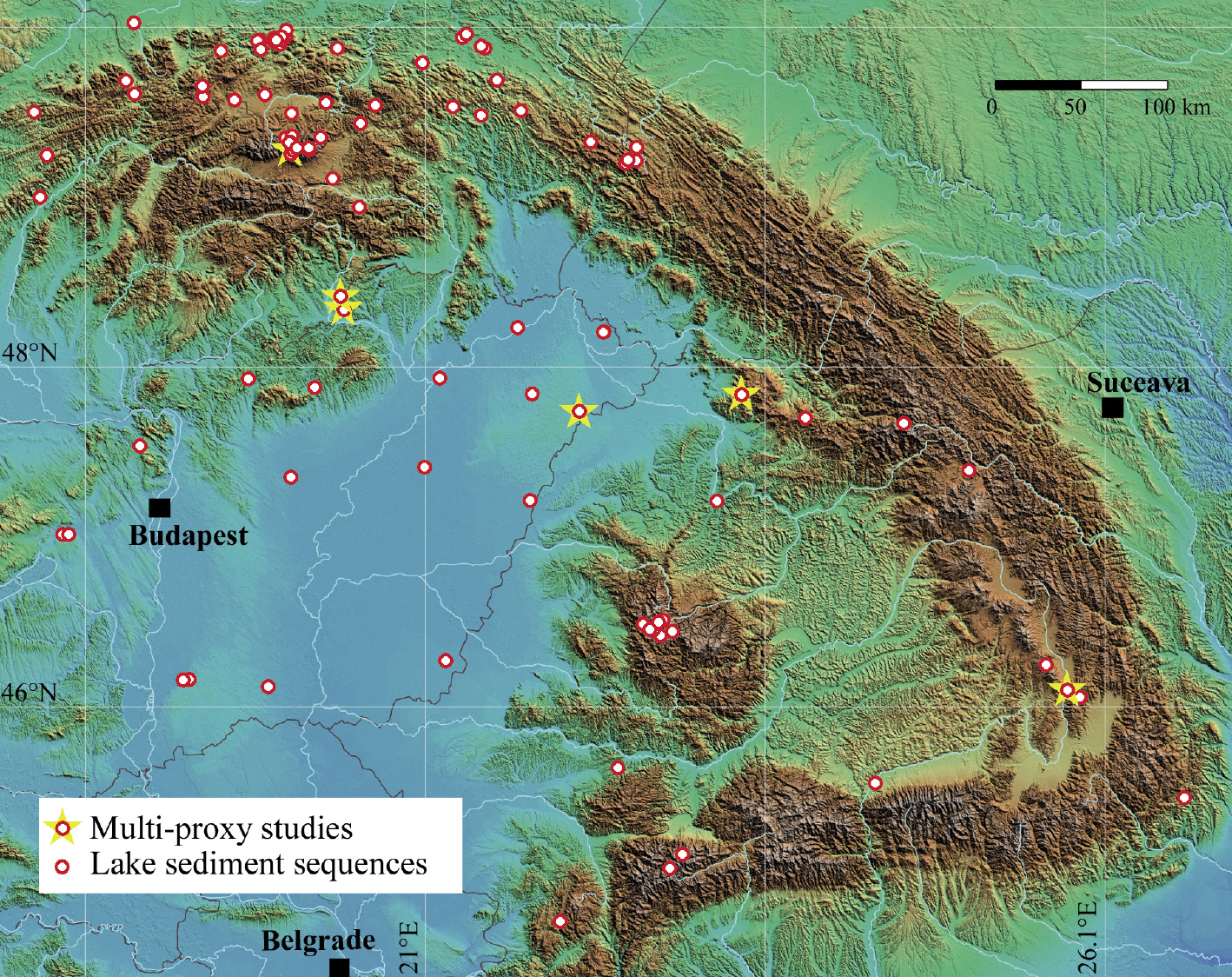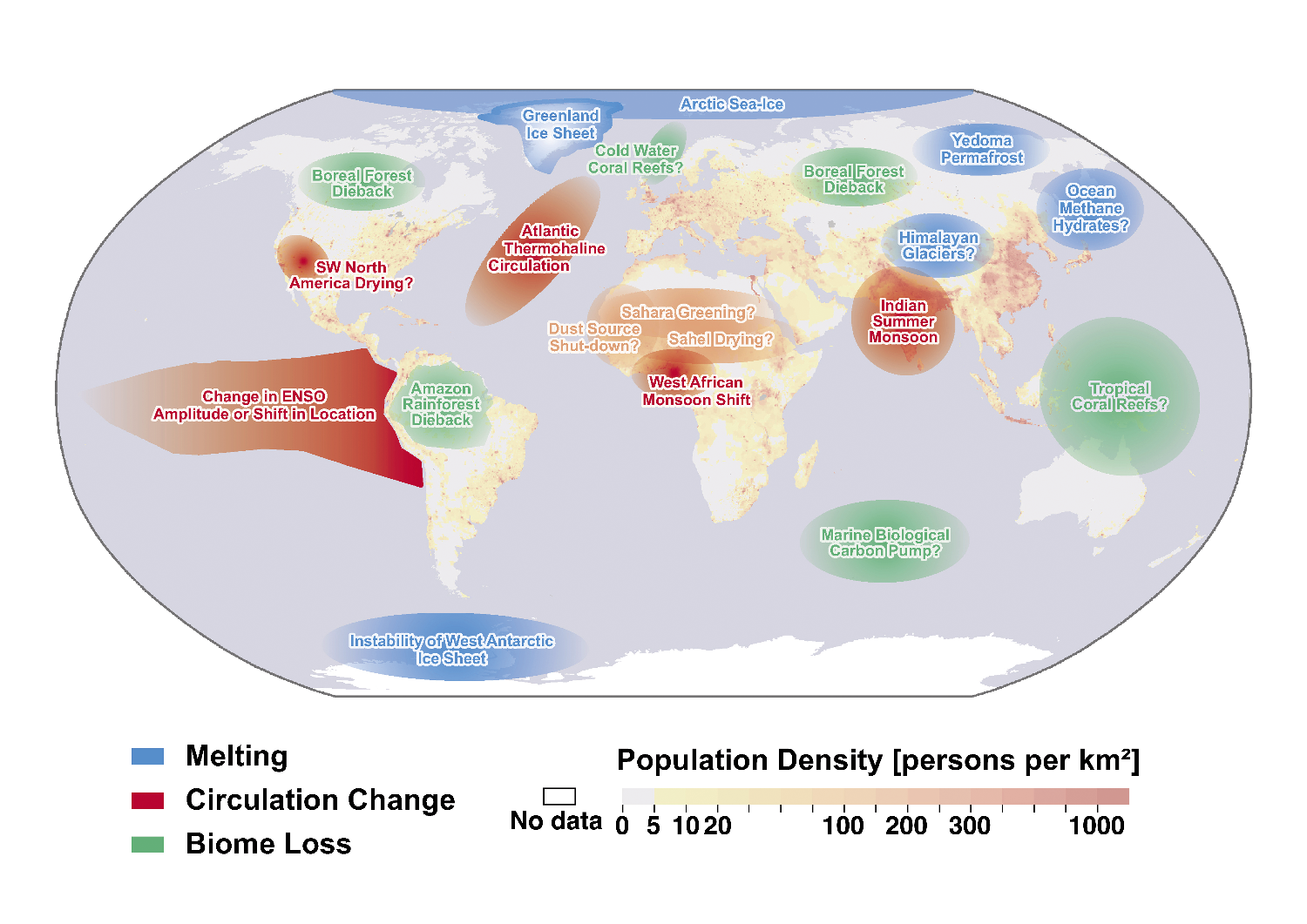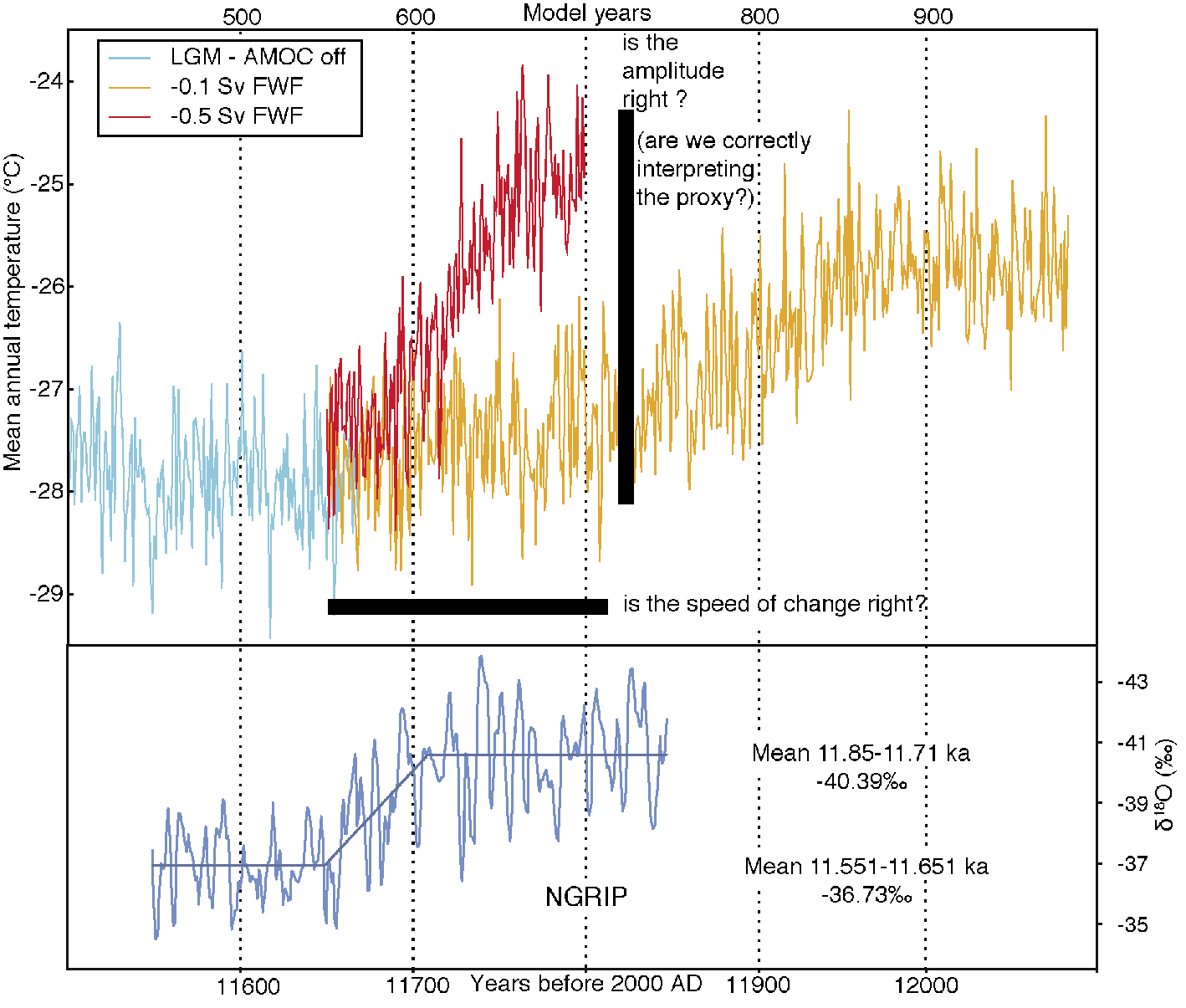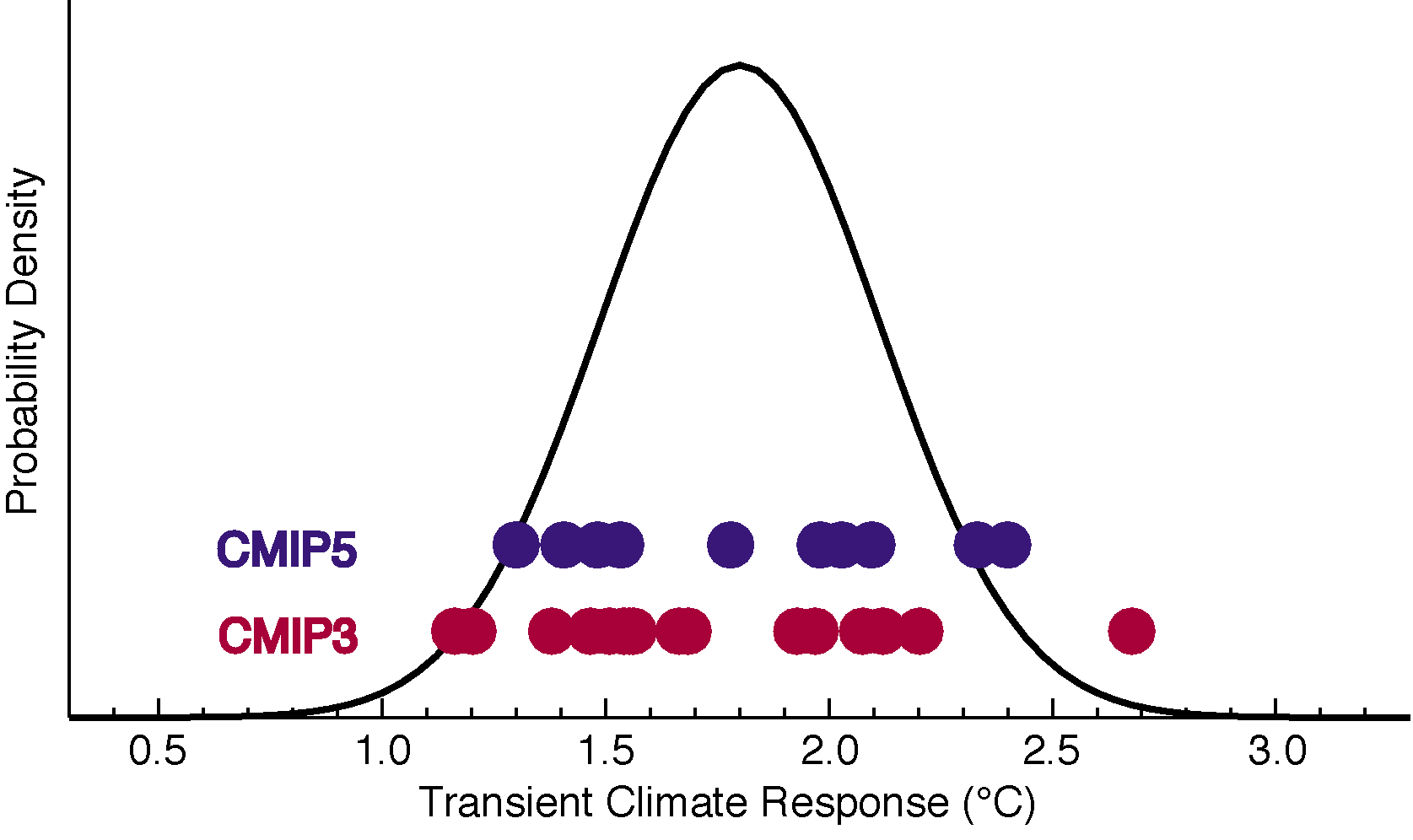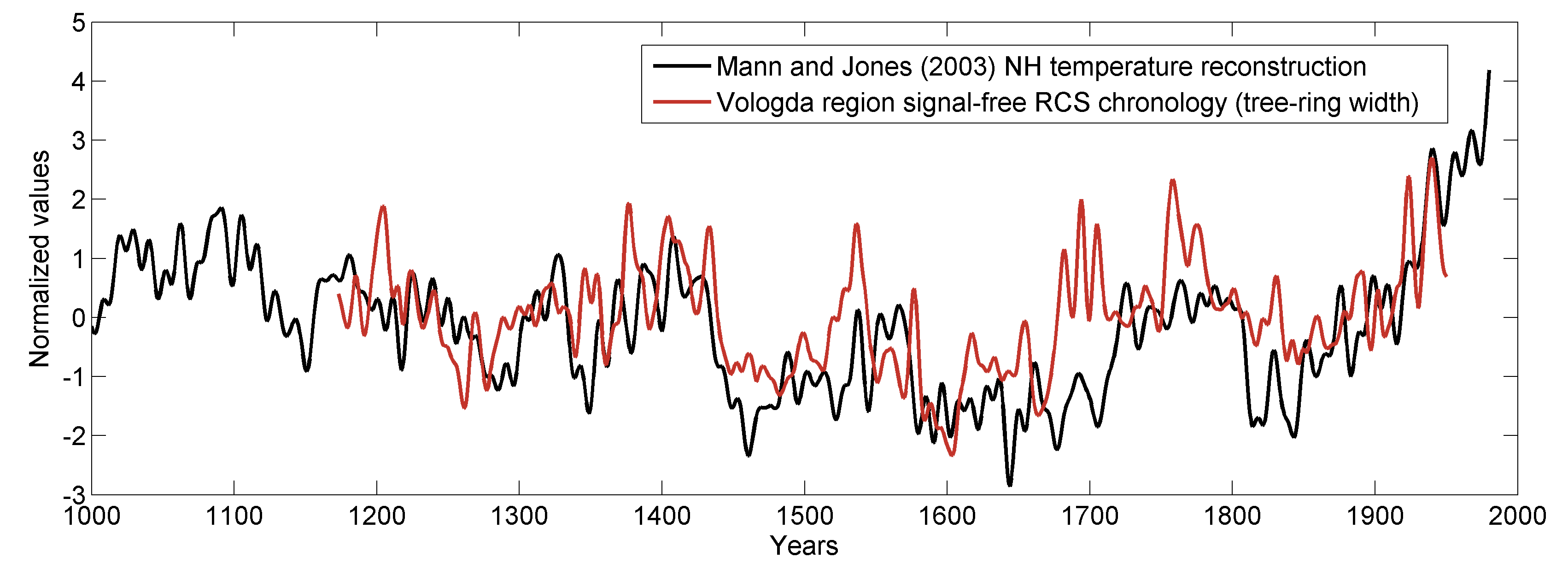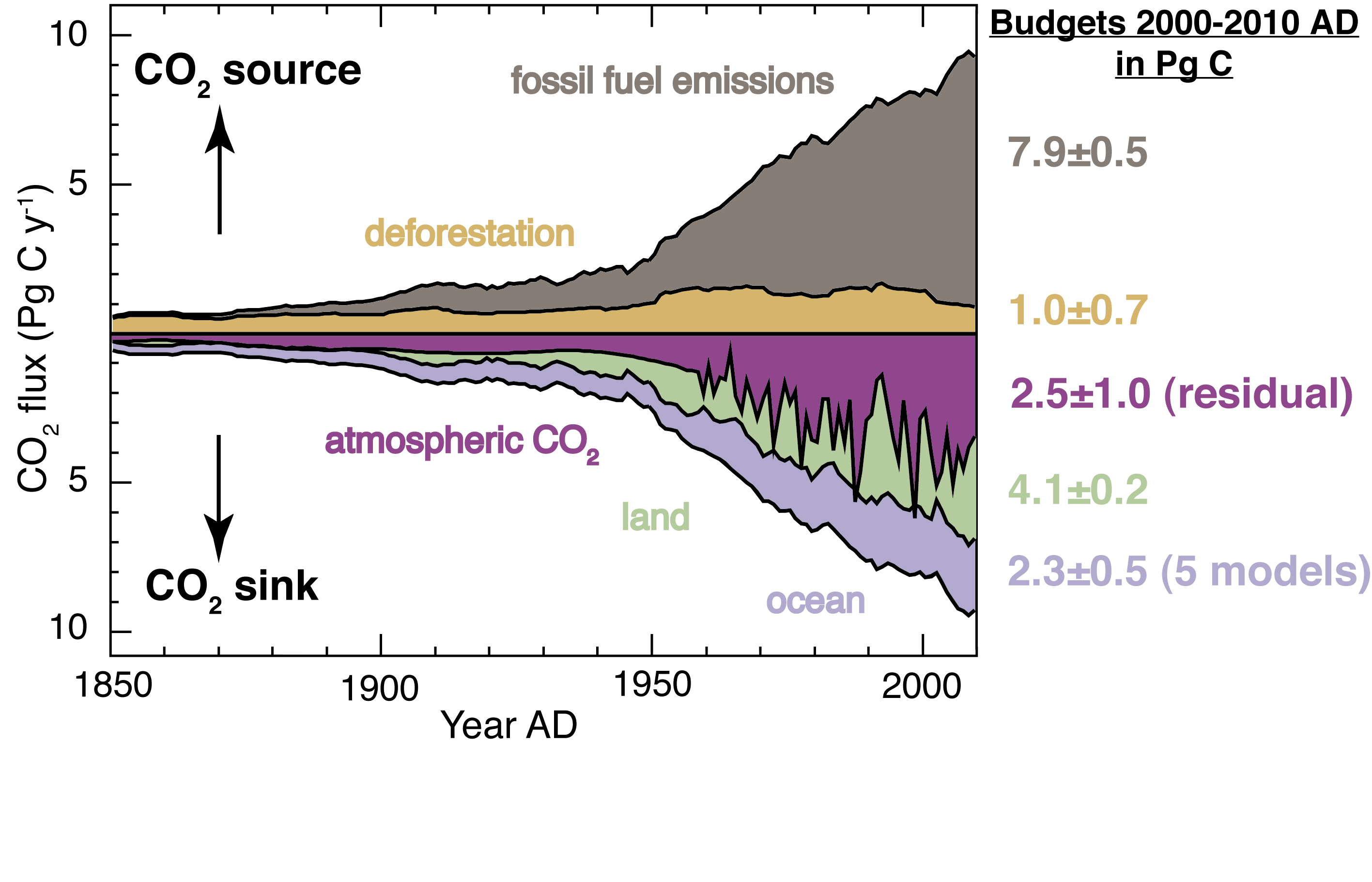- Home
- Taxonomy
- Term
- PAGES Magazine Articles
PAGES Magazine articles
Publications
PAGES Magazine articles
2012
PAGES news
Miyuki Otomo
Scientific ocean drilling, one of the longest running and most successful international collaborations in Earth sciences, is now preparing for a seamless transition from the Integrated Ocean Drilling Program (IODP) to a new program phase. The current IODP, which shall terminate in September 2013, was built upon the accomplishments of the previous two legacy programs Deep Sea Drilling Project (DSDP) and Ocean Drilling Program (ODP), and has conducted cutting-edge investigations of the subseafloor since 2003. IODP employs three complementary types of drilling platforms, each with operational capabilities to support transformative science across a vast extent of Earth’s oceans. The next phase of scientific ocean drilling, the International Ocean Discovery Program, is scheduled to start in October 2013 and will build on the new research plan “Illuminating Earth’s Past, Present and Future”. This science plan outlines the framework for the new IODP with four themes addressing fundamental questions about Earth’s climate, deep-sea life, geodynamics and geohazards (IODP 2011). It will facilitate a long-term and global perspective on some of today’s most pressing environmental issues. Planning for the new phase began in early 2009 with inputs solicited from the international community at the INVEST conference on new ventures in scientific drilling with over 600 scientists from 21 nations.
Multi-platform operations will also serve the science community for the post-2013 program (Fig. 1). Chikyu, the Japanese-operated riser type platform, will provide access to the deep ocean crust, Earth’s mantle, seismogenic zones and hydrocarbon-prone regions. The US-supplied non-riser type vessel JOIDES Resolution, will continue to demonstrate its capabilities with the goal of operating with a full annual schedule. It will address a multitude of science objectives, in particular on climate history and the deep subseafloor biosphere. Finally, the mission-specific platforms provided by the European Consortium for Ocean Research Drilling (ECORD), will be deployed in challenging environments such as in shallow waters and ice-covered waters of the Arctic.
Figure 1: International Ocean Discovery Program (IODP) drilling strategy at the poles and tropics to collect records linking climate, ice sheet, and sea level histories on geologic time scales. Red arrows represent warm water flow beneath floating ice, recently recognized as a key factor in accelerating ice loss from West Antarctica. Elements of this figure were adapted from Schoof (2010).
Subseafloor observatories developed within the ocean drilling community are another key feature of the new science plan. They will collect data at multiple depths along a borehole. These data can be combined with seabed and water-column studies. International collaboration has made it possible to link subseafloor observatories through cabled networks for real-time monitoring off the coasts of Japan, North America and Europe. China is currently developing plans for similar networks.
The new IODP program will continue to offer open access to all data and samples collected during expeditions after a scientific moratorium. Legacy cores collected since the start of the DSDP in 1968 through present are kept in three core repositories and are available for sampling by scientists and for educational purposes. The existing administrative structure of IODP will be maintained. In particular, the international IODP Science Advisory Structure will continue to guide proposal evaluation, scientific technology review, site characterization examination and safety assessment. The journal “Scientific Drilling”, published jointly with ICDP, will continue without interruption.
The main features of the new IODP preserve the international, science-driven and multidisciplinary foundations of the program while providing new and exciting opportunities for oceanographic, microbiological and deep Earth discoveries. The results emerging from new IODP will provide benefits to society by advancing our understanding of geohazards, evolution of life and global climate change.
affiliation
IODP-Management International Inc., Tokyo, Japan; motomo iodp.org
iodp.org
references
IODP (2011) Illuminating Earth’s Past, Present, and Future. www.iodp.org/Science-Plan-for-2013-2023/
Publications
PAGES Magazine articles
2012
PAGES news
Amsterdam, The Netherlands, 29 August - 2 September 2011
Gerald M. Ganssen1 and Michal Kucera2
Planktonic foraminifera have been the true heroes of paleoceanographic research since the birth of the discipline. The ornate shells of these microscopic amoebae are arguably the most important carriers of paleoclimate information available to scientists. Our ability to reconstruct past climate states and comprehend biotic responses to changing oceanic conditions depends on a complete understanding of their ecology, biology and physiology. The quantitative unravelling of the mechanisms by which they incorporate geochemical tracers into their shells is crucial for reconstructing oceanic temperature, pH and salinity.
In recent decades, research on these aspects of planktonic foraminifera has been lagging behind the rapid development of sophisticated geochemical tools and numerical ecological models and their application. To bridge this gap, the Scientific Committee on Oceanic Research (SCOR), together with the International Geosphere Biosphere Programme (IGBP), jointly established a new working group (WG) in 2011, with the aim to stimulate new research, benchmark the current knowledge and disseminate the results to a broad audience. For details of the proposed work of the group, please visit: www.scor-int.org/Working_Groups/SCOR_WG_Foraminifera_revised.pdf.
The first workshop of the SCOR/IGBP Working Group 138 on “Modern Planktonic Foraminifera and Ocean Changes" took place in a stimulating atmosphere of the medieval monastery environs of “Het Bethanienklooster” in Amsterdam. The participants (WG members and invited guests) of the kick-off workshop set the priorities for future work, specified the terms of reference and shaped and planned the deliverables. Specifically, the WG agreed to
a) set-up a Web-based network in cooperation with ongoing (inter)national research programmes and projects to guarantee an open-access, world-wide dissemination of results, data and research plans and
b) to synthesize the state of the science of modern planktonic foraminifera, from pioneering to ongoing research as an eBook or a special issue of an open-access journal. Contents for this foram compendium were drafted. The group decided that eForams (http://eforams.org) will be used as the Internet platform for the deliverables of the WG. The "WG138-eForams fusion" will thus represent an innovative experiment in developing new ways of science dissemination. In the same spirit of innovation in communication with its stakeholders, the WG has documented its aims in short video clips, which are freely available on the Internet (under: A Foram's Tale on YouTube).
In order to expose the aims of the WG to young researchers, the kick-off meeting was accompanied by a one-day focus symposium. It was attended by 18 early-career researchers from six countries and featured keynote presentations by Michal Kucera on genetic diversity and Howie Spero on calcification mechanisms and shell chemistry. The participants were briefed on the progress of the WG and engaged in discussions during the day, over posters and during the scenic canal boat trip in Amsterdam (SCOR Amsterdam meeting also on YouTube). On the morning of the following day, the participants including WG members, guests and young researchers reviewed the deliverables and considered the time plan and modalities to achieve the completion of the ambitious aims of the group.
This marked the closure of the workshop, where the pleasant and open atmosphere set the pace for the work of SCOR/IGBP WG 138. The workshop constituted an excellent opportunity for the group of experts, who met in this form and constellation for the first time, to review the current status and most recent developments in modern planktonic foraminiferal research and engage in exciting and stimulating discussions with the next generation of scientists.
affiliations
1Department of Earth Sciences, VU University, Amsterdam, The Netherlands; g.m.ganssen vu.nl
vu.nl
2Department of Geosciences, University of Tübingen, Germany; michal.kucera uni-tuebingen.de
uni-tuebingen.de
Publications
PAGES Magazine articles
2012
PAGES news
 |
Marcel Mindrescu
Department of Geography, University of Suceava, Romania; marcel.mindrescu gmail.com
gmail.com
1st International Workshop, Suceava, Romania, 9-12 June 2011
The Carpathian Mountains are considered as one of Europe’s last “wilderness” areas, but are nevertheless under heavy pressure from human activities. Examples range from large-scale activities (e.g. sulfur mines in Calimani), ecological disasters (e.g. tailing dam failures in the Toroiaga and Baia Mare areas) to cross-border pollution (e.g. Chernobyl nuclear accident). The current political thrust for development is accelerating the pace of industrial activities, exploitation of natural resources and tourism.
Romania has just recently been integrated into the European Union and many community-based projects were initiated to evaluate problems related to climatic and anthropogenic impacts. However, the Carpathian Mountains remain the least studied mountain range in Europe. This paucity of research projects in the region is reflected by the low number of well-dated and high-resolution paleo-records (e.g. Buczkó et al. 2009, Fig. 1). Rose et al. (2009) published a pollution history study from a lake in the Retezat Mountains at the western extremity of the Southern Carpathians, but no similar studies exist for the rest of the mountain range, despite the abundance of lakes (Akinyemi et al., in press).
The purpose of this workshop was to bring together an international group of scientists interested in the Carpathian-Balkan region to discuss research results and promote opportunities for interdisciplinary and international collaboration. The workshop was co-sponsored by the University of Suceava, the Applied Geography Association (GEOCONCEPT), the Mountain Research Institute (MRI) and PAGES.
The program centered on oral and poster presentations as well as open discussions on the climatic and environmental dynamics during the Pleistocene and Holocene in the Carpathian and Balkan mountains. The workshop featured 36 talks and 15 posters. The 70 participants were from Romania, Hungary, Germany, United Kingdom, Bulgaria, Slovenia, Ukraine, Poland, Switzerland, Czech Republic and Belgium. The entire workshop was webcast and it was educational for young researchers and students by providing them a platform to present their results to an international audience and discuss their research in a multidisciplinary community.
A post-symposium field trip was organized to the formerly glaciated alpine ranges of the Northern Romanian Carpathians (Rodna Mountains), as well as to several large peat-bog accumulations and wetland ecosystems (Iezer lake and Poiana Stampei peat bog).
The organizers of the workshop offered to lead publication of the more advanced workshop contributions in a special issue of the journal Quaternary International and 29 author groups committed themselves to contribute papers.
In order to promote follow-up activities in the region, the “Suceava working group” was created under the lead of Marcel Mindrescu, Angelica Feurdean, Enikő Magyari and Dan Veres. A group website is currently being set up (http://atlas.usv.ro/www/climatechange/) and grant proposals will be prepared. The group will also coordinate the organization of a second regional workshop in 2013 or 2014. Further activities, such as summer camps or meetings in the field will also be considered.
references
Buczkó K, Magyari EK, Bitušík P and Wacnik A (2009) Hydrobiologia 631: 3-28
Publications
PAGES Magazine articles
2012
PAGES news
Ninad R. Bondre1 and Thorsten Kiefer2
It is only in the present that we can study Earth processes as they occur. But sometimes due to a lack of information and sometimes due to an excess of it, we rarely know how those processes will unfold tens or hundreds of years from now. The finitude of the present precludes a comprehensive understanding of all Earth system processes and of the possible scenarios for the future, and it is the past that we must turn to in order to fill in the blanks. Past events are but traces of ancient processes frozen in time, affording us the luxury of knowing how it all ended. The present may very well be the key to the past, but the past represents a future that once was.
One of the achievements of the International Geosphere-Biosphere Programme (IGBP) and its projects has been to facilitate the movement from the present to the past and back to the present so as to build and refine our understanding of global change. As an uncertain future looms large, we rely more than ever on this approach. This issue of the Past Global Changes (PAGES) newsletter features paired perspectives that address the present and the past as two sides of the same coin, seeking to provide a window into the future. The topics cut across the research carried out in IGBP's projects and beyond on land, oceans, the atmosphere and their interfaces. The bringing together of communities, we feel, is timely in the context of the move towards the new Future Earth program by the International Council for Science (ICSU) and its partners.
We came up with a list of topics and one key question per topic after extensive consultation with the PAGES and IGBP communities. The topics do not cover Earth-system science comprehensively; instead, they reflect the lowest-hanging fruit, i.e. topics where substantial research is carried out on present as well as on past timescales alike. In principle, the article pairs were to address whether and how a particular process or phenomenon would change in the future. In practice, the articles reflect both the diversity of the topics and of the backgrounds and perspectives of the authors. Although dialogues developed between some of the authors of the complementary articles, we did not intentionally attempt to streamline the pairs of articles. This was because we wanted to maintain the duality of the perspectives.
The space restriction to one page for each article by no means allows a comprehensive response to the key questions. But the articles provide different yet complementary takes that also illuminate the questions themselves. There are indications in many articles regarding specific bits of information from the past or the present that could help enhance our process understanding and our projections of the future. Much in the articles remains inchoate, and we have no doubts that the active engagement of our readers will help make them more complete.
The communities studying the past and the present are by no means exclusive, but there can be a tendency for compartmentalization, primarily due to substantially different methods and approaches, but also due to the realities of today’s academic environment. By placing side by side the perspectives on the future from the vantage points of the past and the present, we hope to both remind ourselves of the common ends and reaffirm the value of diverse perspectives and collaborations across time scales.
affiliations
1IGBP Secretariat, Royal Swedish Academy of Sciences, Stockholm, Sweden; ninad.bondre igbp.kva.se
igbp.kva.se
2PAGES International Project Office, Bern, Switzerland
Publications
PAGES Magazine articles
2012
PAGES news
Tim Lenton
College of Life and Environmental Sciences, University of Exeter, UK; t.m.lenton exeter.ac.uk
exeter.ac.uk
How well can Earth system models simulate the dynamics of global change? Well, if we wait long enough, we’ll find out. But by then the models being judged will be deemed out-of-date and the latest models will be argued to be far superior! Recently models have under-predicted the rate of global warming and sea-level rise (Rahmstorf et al. 2007), and have failed to forecast the abruptness of Arctic sea-ice retreat (Stroeve et al. 2007) or the start of ocean de-oxygenation. This does not bode well.
When the dynamics of global change are basically linear – that is, the response is proportional to some forcing – and the forcing and response are accurately captured, the models should do a good job. Global warming in response to radiative forcing would be a great example, if only the radiative forcing effects of aerosols and the climate sensitivity to a given radiative forcing were not both highly uncertain (see pages 10/11 and 20/21 of this issue). The best way to reduce this uncertainty is to continue to reduce aerosol forcing and wait to see the climate response.
The prediction problem gets more difficult when the dynamics of change could be highly non-linear. Current global models struggle to capture potential climate “tipping points” at sub-continental scales (Fig. 1) (Lenton et al. 2008). For example, observations support the theory that the Atlantic meridional overturning circulation is “bi-stable” with an alternative collapsed state stable under the present climate, which it could conceivably be tipped into (Drijfhout et al. 2011). Yet the last generation of models were systematically biased, with just one stable ocean circulation state (Drijfhout et al. 2011), so it is no surprise that they did not forecast the possibility of future collapse (IPCC 2007).
Sometimes key processes or systems are simply missing from the models. Collective inability to put a number on the future contribution of ice sheets to sea-level rise (IPCC 2007) has provoked a welcome revolution in the modeling of ice-sheet dynamics. But we must be wary of the “kitchen sink” tendency to keep putting more and more into Earth system models. Increasing complexity has been sold on the argument that it will reduce uncertainty in future projections, but it was never going to do that. Uncertainty has predictably increased as more forcing agents, couplings and feedbacks have been added to the models.
Century-scale runs with multiple simultaneous forcing agents and feedbacks are important for policymakers, but not the most scientifically informative if one wants to isolate the effects of a particular forcing or feedback, or attribute the causes of a particular change. What we need is a new way of using models together with available data to bridge the widening gap between predictive modeling and mechanistic understanding. The ocean overturning example highlights the need to recalibrate models using available data to get their stability properties right. But this is not just an initial condition problem; it will involve altering the parameters and even the processes in the models.
Earth system models are still at heart climate models with bits added on. This is of course sensible if – as many of us believe – climate change is the most dangerous global change that we as a species are driving. But it is worth considering the possibility that another global change might turn out to be more important. If, for example, our rampant mining of phosphates and fixing of nitrogen could ultimately trigger a global oceanic anoxic event, do we have a well-posed tool to assess this? Century-scale climate models are clearly inappropriate. Intermediate complexity models may be better posed. But I still see a need for truly ”Earth system” models that can help define all of our planetary boundaries (Rockström et al. 2009).
selected references
Full reference list online under: http://pastglobalchanges.org/products/newsletters/ref2012_1.pdf
Drijfhout S, Weber S and van der Swaluw E (2011) Climate Dynamics 37: 1575-1586
Lenton TM et al. (2008) PNAS 105: 1786-1793
Rahmstorf S et al. (2007) Science 316: 709
Rockström J et al. (2009) Nature 461: 472-475
Stroeve J et al. (2007) Geophysical Research Letters 34, doi: 10.1029/2007GL029703
Publications
Earth system models - How well do Earth system models simulate the dynamics of global change? [Past]
PAGES Magazine articles
2012
PAGES news
Masa Kageyama
Laboratoire des Sciences du Climat et de l'Environnement, CEA Saclay, Gif-sur-Yvette, France; Masa.Kageyama lsce.ipsl.fr
lsce.ipsl.fr
Climate models, in particular the “big” general circulation models used for climate prediction, are first evaluated in comparison to present climate. This step is crucial, but does not warrant a correct sensitivity to external forcings or a realistic representation of the speed of climatic changes under time-dependent forcings. As underlined by Tim Lenton (this issue), it is unreasonable to just wait and see if the climate changes predicted by the current models have actually happened. But we can turn to the past and to the numerous paleo-records.
What do they tell us? That it is impossible to find a close analogue to the recent and probably future climate change in the paleo-record, in terms of forcing and in terms of the speed at which it occurs. But there are periods warmer than present and there are periods of abrupt climate changes. These past scenarios provide an endless list of challenges for climate – and more generally Earth System – modelers. The challenges fall into three categories. Are we able to model (and thus prove we understand) (1) the direction, (2) the amplitude and (3) the speed of the reconstructed climate changes?
For a long time, general circulation models have only been used to tackle the first two tasks, by considering simulations at equilibrium with external forcings and boundary conditions different from today. The Palaeoclimate Modelling Intercomparison Project (Braconnot et al. 2007) has led such comparisons for the Mid-Holocene (MH) and the Last Glacial Maximum (LGM). Very often, the models have proved to be able to simulate the sign of the reconstructed climate differences, but not their amplitude, e.g. in African monsoon amplification during the Holocene or for the European or Greenland cooling during the LGM. Does this prove the models have a too low sensitivity? Maybe, and there are many processes (e.g. vegetation, ice-sheets) that models do not account for yet. Their inclusion could increase model sensitivity to external forcing, at least regionally. On the other hand, we have to remember that the paleo-climatic reconstructions are also based on assumptions and associated with uncertainties. Direct (“forward”) modeling of the paleo-climate indicators such as vegetation, oxygen isotopes or abundance of foraminifera offers a solution by accounting for multiple factors controlling the environmental indicators. Forward modeling has shown that formerly neglected processes needed to be considered in the interpretation of a record and that this can result in more satisfactory model-data comparisons than those between modeled and reconstructed climate variables (e.g. LeGrande et al. 2006).
This is only a first step. As questions on the speed of future climate change and our ability to adapt to them arise, we can return to the paleo-record. On which timescales can climatic change occur? Our knowledge on this topic has greatly increased since a few decades ago, when climate history was considered to occur on tectonic and Milankovitch (ice age) time-scales only. The discovery of abrupt climate changes in Greenland and elsewhere during the last glacial cycle has raised the challenge to understand changes that occurred over a few decades or even just a few years (Steffensen et al. 2009), much shorter than the time-scale at which the external forcings evolved (Fig. 1).
These short time-scales imply that “big” models can now be used to test our understanding of these fast climate changes, in addition to Earth System Models of Intermediate Complexity (EMICS). EMICS have the advantage of running fast and include representations of the slow components of the climate system. As such, they have been used extensively to study climate evolution, but the origin of the abrupt Dansgaard-Oeschger warmings is still elusive. So far, no model, neither EMIC nor GCM, has been able to simulate such transitions without imposing ad-hoc fresh water flux forcings. Are our models too simple? Are there missing processes in our understanding? Do we overinterpret the proxies? Are the very fast climatic shifts recorded in Greenland the result of a large change in interannual variability superimposed on a slower climate evolution? On this topic, big models, equipped with “proxy simulators” might bring new enlightening perspectives.
references
Full reference list online under: http://pastglobalchanges.org/products/newsletters/ref2012_1.pdf
Braconnot et al. (2007) Climate of the Past 3: 261-277
Publications
PAGES Magazine articles
2012
PAGES news
Mat Collins and David Long
College of Engineering, Mathematics and Physical Sciences, Exeter University, UK; M.Collins exeter.ac.uk
exeter.ac.uk
The Climate Sensitivity (CS) is a key parameter for assessing future climate change, as is its counterpart the Transient Climate Response (TCR – see figure 1). The TCR is defined as the 20-year global, annual mean temperature change averaged around the time of CO2 doubling, under a forcing scenario of CO2 increasing at a rate of 1% per year compounded. Just like the CS, the TCR quantifies physical feedbacks in the climate system associated with the surface, clouds, water vapor, sea ice, etc., but it is more relevant for transient climate change in the near future and does not suffer from the ”long tail” evident in estimates of the CS (Frame et al. 2005).
A notable feature of the latest version of the Coupled Model Intercomparison Project (CMIP5) is that atmosphere models coupled to simple slab or mixed-layer oceans are not included in the design, limiting a direct comparison of the range of CSs with previous versions of CMIP (although the CS and TCR tend to be well correlated in models and the effective CS can be calculated from experiments included in CMIP5).
We may use modern observations to aid in building complex models of the climate system from “first principles” i.e. by solving the dynamical equations of the atmosphere and ocean and parameterizing sub-grid-scale processes in as much detail as possible. Multiple data sources may be used to evaluate both the individual building blocks and the emergent properties of the model; data from process-based observations, possibly gathered during dedicated field campaigns, historical in situ measurements, remotely sensed data, etc. We can then interpret measures such as the CS and TCR computed from complex modes as estimates that integrate our understanding of climate (embodied in the laws of physics) and modern day observations.
The range of CS and TCR has not changed much in successive generations of models. The example in the figure shows a range of 1.2-2.6ºC for the CMIP3 models and 1.3-2.4ºC for the CMIP5 models available at the time of writing.
An alternative approach comes from using simple climate models that may only simulate aggregate variables such as global mean temperature. Simple models can be run many times and statistical approaches can be used to formally estimate the parameters of the model based on constraints from observations/estimates of e.g. recent ocean heat uptake and radiative forcing. Measures such as CS and TCR then come with likelihood estimates and the uncertainty may be expressed as a probability density function (PDF – see Fig. 1).
Unfortunately, using different observational data sources from different modern (and paleo) time periods, have not produced tight constraints on variables such as the TCR. The 5-95% range in the example from the figure from (Gregory and Forster 2008) is 1.3-2.3ºC, comparable with the ad hoc range from CMIPs. CMIP ranges of CS are also comparable with observationally constrained PDFs (Knutti and Hegerl 2008).
As the signal of climate change emerges from the noise of natural variability, PDFs based on simple-model constraints should narrow. Collection of new and more detailed modern observations, particularly of climate processes such as clouds, should allow us to better improve and evaluate our complex models. One recent approach combines complex modeling with formal parameter estimation to produce PDFs of global and regional change (Sexton et al., in press). This allows multiple modern observational records to be used to constrain projections, although the cost of implementation is high. There is still scope for much research in quantifying how sensitive Earth’s climate is to CO2 change using modern models and data.
selected references
Full reference list online under: http://pastglobalchanges.org/products/newsletters/ref2012_1.pdf
Frame D et al. (2005) Geophysical Research Letters 32(9), doi:10.1029/2004GL022241
Knutti R and Hegerl G (2008) Nature Geoscience 1(11): 735-743
Meehl GA et al. (2007) Bulletin of the American Meteorological Society 88(9): 1383-1394
Sexton D, Murphy J, Collins M and Webb M (in press) Climate Dynamics, doi: 10.1007/s00382-011-1208-9
Publications
PAGES Magazine articles
2012
PAGES news
Irina Bushueva and Rejep Kurbanov
Institute of Geography, Russian Academy of Sciences, Moscow, Russia; irinasbushueva gmail.com
gmail.com
Vistula Spit, Russia, 5-10 September 2011
Vistula Spit, a sandy stretch of land between the Baltic Sea and the Vistula Lagoon, was a perfect place to discuss interactions between land, ocean and atmosphere. The Young Scientists Meeting was initiated under the umbrella of the International Geosphere-Biosphere Programme (IGBP) and co-sponsored by PAGES and the Scientific Committee on Oceanic Research. The conference organization was a joint effort of three institutions within the Russian Academy of Sciences: the Institute of Geography, the P.P. Shirshov Institute of Oceanology and the A.M. Obukhov Institute of Atmospheric Physics. The conference was hosted by the Institute of Oceanology at the Field Research Station “Baltic Spit”.
The conference attracted 79 early career and 11 established scientists from 10 countries interested in climatic, environmental and socioeconomic aspects of global change on modern and paleo timescales. It provided a great opportunity for extensive discussion and international networking between young scientists and high-level experts.
Land-Ocean-Atmosphere interactions in the context of global changes were discussed in four sessions on (1) monitoring changes and (2) understanding the mechanisms of interaction, (3) social problems in the changing world, and (4) reconstruction and forecast of climate and environmental changes. The sessions started with invited lectures from senior scientists and were followed by oral and poster presentations of young scientists. Additionally to the scientific lectures, the directors of two international projects T. Kiefer (PAGES) and A. Reissel (iLEAPS) presented overviews of their projects’ activities and the opportunities for young scientists.
In the paleoscience session, A. Pospieszyńska presented optical density analyses of wood from living trees and historical buildings, and characterized pre-instrumental climate in Poland. O. Maksimova reported on tree-ring research from the upper tree line in Tien Shan Mountains. Maximum density correlates with summer temperatures and allowed reconstructing June-August temperatures for 1650-1995 AD. V. Matskovsky presented two new absolutely dated tree-ring width chronologies from the Vologda region (1195-2009 AD, Fig. 1) and the Solovki islands (1187-2008 AD). Both chronologies correlate significantly with European Russian high-resolution temperature reconstructions from pollen and historical data, and with Northern Hemisphere summer temperatures.
I. Bushueva presented high-resolution reconstructions of mountain glacier variations in the Caucasus over the last 400 years. I. Sokolov discussed changes of glaciers on the Franz Josef Land archipelago. U. Pączek aimed to identify short-term climatic oscillations in sediments from the Gulf of Gdańsk (southern Baltic Sea). The data reveal great variability in sediment composition that indicates sensitivity to regional climatic and local hydrodynamic conditions. A. Dolgikh described his work on soil horizons in the habitation deposits of ancient cities of European Russia. E. Kotlovanova and colleagues inverted 87 borehole temperature profiles (67 from Urals, 20 from Eastern Europe) into ground surface temperature histories. Temperature minima between 1700 and 1900 AD were followed by climate warming.
R. Przybylak and P. Wyszyński compared the meteorological conditions in the Arctic during the 1st International Polar Year (1882/83) with data from the period 1961-1990 AD. Meteorological conditions during the early instrumental period were not significantly different from the later 20th century.
Further presentations were given on geological evidence from Sicily about the Messinian salinity crisis (A. Rybkina), coastal dynamics of Cheleken peninsula (R. Kurbanov), alongshore currents at the eastern Pacific margin (M. Kladovschikova) and fluctuations of Baltic Sea level (E. Kochetkova).
The plenum of young scientists awarded the most enthusiastic young scientist Igor Kozlov (Russia) with a “dream house” candlestick. His presentations were dedicated to using Synthetic Aperture Radar satellite data for oceanographic studies. Aleksandra Pospieszyńska (Poland, see above) received the same gift as an award for her excellent presentation from the established scientists.
Figure 1: Comparison of Vologda region (60°N, 38°W) signal-free Regional Curve Standardization (RCS) tree-ring width chronology (red) with the Mann and Jones (2003) northern Hemisphere (NH) temperature reconstruction (black) (Correlation R=0.59). The Little Ice Age is well pronounced during 1450-1660 AD.
reference
Mann ME and Jones PD (2003) Geophysical Research Letters 30(15), doi: 10.1029/2003GL017814
Publications
PAGES Magazine articles
2012
PAGES news
Gavin A. Schmidt
NASA Goddard Institute for Space Studies, New York, USA; gavin.a.schmidt nasa.gov
nasa.gov
The climate record definitively shows that the Earth's climate is sensitive to various drivers, including greenhouse gases, orbital variations and continental shifts. Unfortunately, there are no past analogs for the anticipated 21st century climate changes, and so a principal challenge in applying these constraints to the future is to interpret these changes quantitatively.
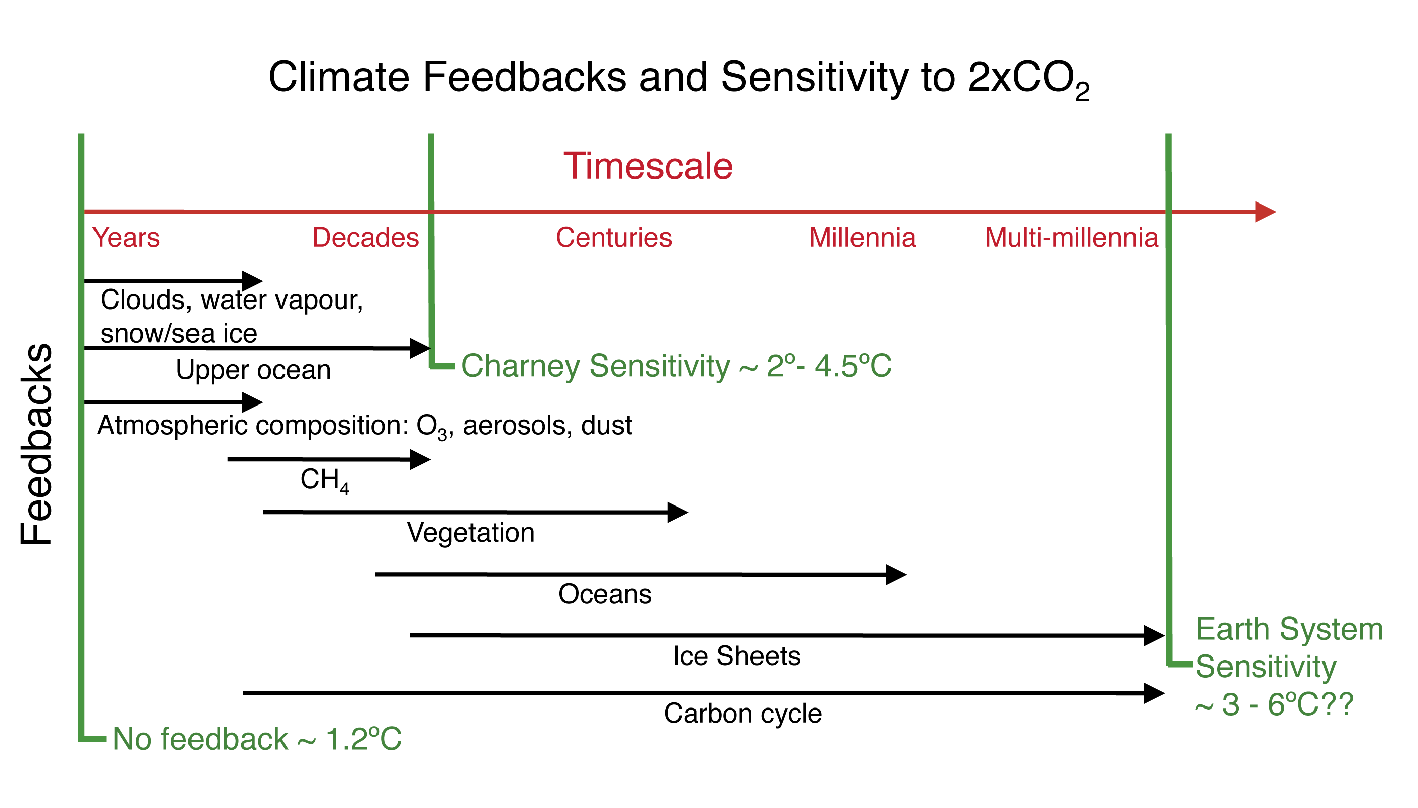 |
|
Figure 1: Climate sensitivities are a function of what feedbacks are included and what timescales are being considered. |
At the global scale, the framework of radiative forcing and response is a powerful method to constrain sensitivity, however, there are many nuances. First, the system being described needs to be defined - what are the forcings, and what are the responses? This might seem clear at first glance, but actually depends on the availability of data and what timescales are being considered (Fig. 1). Second, there needs to be clarity in how the calculated sensitivity relates to either the “climate sensitivity” determined by models, or the related concept of the transient climate response.
The commonly used “Charney sensitivity” - the equilibrium surface temperature response to 2xCO2 allowing most atmospheric processes to react, but holding ice sheets, vegetation, atmospheric composition and ocean circulation constant - is a useful climate model metric. Constraining this from paleo-data requires information on all the “constant” components, most notably for the Last Glacial Maximum (LGM), where many (though not all) the elements are available (Köhler et al. 2010; Schmittner et al. 2011), and perhaps the last millennium, where many aspects are not fundamentally different from today (Hegerl et al. 2006). However, while the Charney sensitivity is a useful characterization of the any particular atmospheric model, it is not the same as what would actually occur if 2xCO2 were reached and maintained for a long time.
There are important nuances: climate sensitivity to cooler conditions might not be equivalent to climate sensitivity to warmer ones (indeed evidence suggests it is 80 to 90% smaller; Hargreaves et al. 2007; Crucifix 2006; Hansen et al. 2005) and some forcings just can't be fitted into a global forcing/response framework at all (such as orbital variations). Furthermore, there is often substantial uncertainty in the forcings - whether it is the size of ice sheets at the LGM, or solar forcing in medieval times, that must be taken into account in assessing the uncertainties in any estimates.
Constraining any sensitivities from the paleo-record is thus still a work in progress. Predominantly data-driven approaches (like Köhler et al. 2010 or Lorius et al. 1990, for the LGM) suggest a Charney sensitivity of around 3ºC (with a 2σ range of ~1-5ºC). Synthesis estimates that use a combination of intermediate models constrained by LGM paleo-data have given ranges of 1.2-4.3ºC (5-95%) (Schneider von Deimling et al. 2006) and 1.7-2.6ºC (17-83% range) (Schmittner et al. 2011). Note however, that the latter estimate includes a vegetation feedback, not included in the standard definition of the Charney sensitivity. A correction for this reduces the estimated sensitivity by about 0.2ºC. There is a large (and as yet barely quantified) sensitivity to model structure in these calculations since the models used to date do not give a very good fit to the regional details of the proxy data.
By expanding the framework to incorporate excluded fast and slow feedback elements, it is possible to estimate the long-term “Earth System Sensitivity” (ESS) (Lunt et al. 2010; Hansen et al. 2008), i.e. the temperature realized after all the feedbacks have worked themselves out. For instance, Lunt et al. (2010) found that the addition of ice sheet and vegetation responses (derived from Pliocene proxy data), increased their model sensitivity to CO2 by ~50%. However, this will apply only at very long timescales (many tens of thousands of years or even longer). Intermediate definitions of the sensitivity might also be calculated - for instance, taking dust, aerosol and ozone changes (fast atmospheric responses) or ocean circulation changes as feedbacks as well, but still holding ice sheets and vegetation constant.
Linking estimates of climate drivers in the past, estimates of the climate response, and the prospects for future change is however a crucial task (Schmidt 2010). To a large extent it requires the use of climate models, and the incorporation of a paleo-climate modeling component in CMIP5 will serve as a good testbed for using the paleo-record to assess the credibility of many aspects of the future projections (not simply the global mean temperature sensitivity).
selected references
Full reference list online under: http://pastglobalchanges.org/products/newsletters/ref2012_1.pdf
Hargreaves JC, Abe-Ouchi A and Annan JD (2007) Climate of the Past 3(1): 77-87
Köhler P et al. (2010) Quaternary Science Reviews 29: 129-145
Lunt DJ et al. (2010) Nature Geoscience 3: 60-64
Publications
Carbon cycle dynamics - How are major carbon sinks and sources varying with global change? [Present]
PAGES Magazine articles
2012
PAGES news
David Schimel
National Ecological Observatory Network, Boulder, USA; dschimel neoninc.org
neoninc.org
The entire Earth System, atmosphere, oceans, biology and geology are involved in the carbon cycle (Archer 2010). Carbon dioxide is taken up by the land biosphere through photosynthesis, and released through respiration and combustion (Schimel et al. 2001). The oceans take up carbon through closely coupled physical, chemical and biological processes (Sarmiento and Gruber 2006). They absorb carbon dioxide in regions where mixing and biological activity maintain low ocean carbon dioxide levels, allowing chemical diffusion from these active regions of the sea. In other regions, carbon-rich water mixes to the surface and releases carbon to the atmosphere. These processes are natural and have always occurred.
The anthroposphere, the sphere of human activities, transforms this cycle in two ways. First, humans burn carbon from geological reservoirs that would normally be stable over millions of years and introduce this additional carbon into the more active atmosphere-ocean-land system, increasing the total amount of carbon circulating in the Earth System (Archer 2010). Second, human land use converts biologically stored carbon in soils and plants to carbon dioxide in the atmosphere, changing the balance of stored and circulating carbon (Schimel 1995).
These human activities increase atmospheric carbon dioxide and thereby the trapping of heat in the atmosphere, leading to global climate change. As climate changes, it has consequences for the carbon cycle. The rates of many biogeochemical processes, such as photosynthesis, respiration, nitrogen cycling and wildfire increase in warmer conditions (Field et al. 2007). These higher process rates may speed up biological activity, producing potential positive and negative feedbacks to the carbon cycle. In some models, the feedback effects of the carbon cycle influence atmospheric CO2 by tens to even hundreds of parts per million, corresponding to significant effects on temperature (Cox et al. 2000). Temperature effects may be largest in high latitude regions, where enormous post-glacial deposits of carbon in permafrost could be released as CO2 and methane as these soils thaw (Koven et al. 2011).
Precipitation also changes as the warming atmosphere causes more evaporation. This intensification of the hydrological cycle will cause some regions to become wetter, but arid regions may become drier. Drier conditions in the tropics will decrease plant growth and reduce carbon storage in these regions (Fung et al. 2005). Warmer and wetter conditions in mid-latitude regions may actually increase carbon storage. Most evidence suggests the tropical effects are larger, leading to overall release of ecosystem carbon stores. This creates a global feedback increasing atmospheric carbon dioxide as temperatures warm.
When humans burn fossil fuels, they transform organic carbon compounds that last for millions of years into atmospheric carbon dioxide. The uptake and stabilization of carbon dioxide into long-lived carbon compounds – which defines the lifetime of carbon dioxide – takes a lot of time. While photosynthesis and air-sea gas exchange can draw CO2 concentrations down quickly, i.e. within years, actually transferring that carbon into stable chemical forms, safe from recycling back to the atmosphere requires ten to thirty thousand years (Archer 2010).
Because of the long lifetime of changes to the carbon cycle, the paleo-perspective is critical. For example, paleorecords tell us that while atmospheric carbon dioxide concentrations can increase quite rapidly, it can take much, much longer for it to be locked into long-lasting forms and provides a timescale for these dynamics. During one well-documented event 55 million years ago, atmospheric carbon dioxide nearly doubled over about 20,000 years, with an accompanying increase in temperature of perhaps 6°C. While atmospheric carbon dioxide increased very rapidly, it took nearly 7-8 times longer to return to previous levels (Doney and Schimel 2007).
Carbon scientists are finding creative ways to combine paleodata, process studies and modern-day observations to model the ”fast out-slow in” processes that determine the longevity and severity of climate change. The paleorecord provides an essential observational basis for assessing the reality of model-based scenarios of the long-term future.
references
Full reference list online under: http://pastglobalchanges.org/products/newsletters/ref2012_1.pdf
Archer D (2010) The Global Carbon Cycle (Princeton Primers in Climate), Princeton University Press, 224 pp
Doney SC and Schimel DS (2007) Annual Review of Environment and Resources 32: 31-66
Cox PM et al. (2000) Nature 408: 184-187
Fung IY, Doney SC, Lindsay K and John J (2005) PNAS 102: 11201-11206


